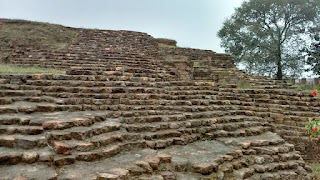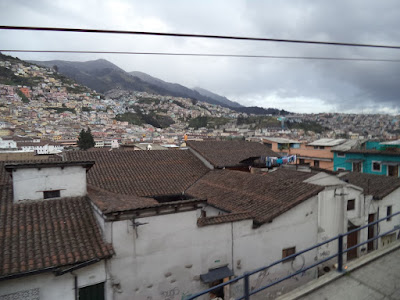 |
| COTOPAXI IN THE DISTANCE |
The
quake in Ecuador took me back to my recent visit to that country, a very
enjoyable one. The capital Quito has three major volcanoes nearby, all of which
are tourist destinations. They are part of what is known as the ‘Pacific Ring
of Fire’, a group of active volcanoes that is in the shape of a horseshoe and
passes from Western coasts of South and North America through the Pacific to
Southeast Asia and reaches pretty close to India. In fact the 2004 Tsunami in
South Asia in which thousands lost their lives and an entire train was washed
away in Sri Lanka, was attributed to an under-sea volcanic eruption off the
coast of Indonesia which is on the ‘Ring.’
Ecuador
is bang on the Andes mountain chain and the tallest volcano it has is Cotopaxi (20000
feet), currently off-bounds for tourists as signs of activity have been noticed
in it since 2015. But this does not take away from the fact that it is a symbol
of Ecuador and even finds a place on its flag. A slightly lesser
one is Cayambe northeast of Quito and at 19300 feet is the second highest
mountain in the Ecuadorian Andes. The third is Pichincha which is very close to
Quito. The province is named after this volcano. I went close the top two of
them – Pichincha and Cayambe. Pichincha is right next to Quito and can be
quickly reached by a Gondola which takes one from about 10,000 feet to 14000 ft.
in just a few minutes. Cayambe is a little way off – about 70 kilometres to the
northeast – and is a little tougher to reach. Cayambe is the name of the
indigenous people who live in the region around the volcano. The small but old
town at the base is also known as Cayambe. What follows is an account of the
visit to Cayambe volcano or to be exact to the point where the glacier begins
which is about 4000 feet below the crater. I was curious to see a volcano since
the only one that I know of in India is Jwalamukhi in Himachal Pradesh which I
have never visited.
Therefore
we (my friend and me) decided to pay a visit to Cayambe and accordingly hired a
tourist taxi for the purpose. We started off from our hotel ‘Sol De Quito’ (The
soul of Quito) on Alemania Avenue in Quito early on a clear morning in a
Hyundai MPV. Accompanied by the driver (a lady in blue jeans and jacket), and
the guide we drove through the countryside dotted with green-houses where
flowers are grown on a commercial basis (flowers by the way are a major export
of Ecuador) stopping only once on the outskirts of Quito to take a picture of Cotopaxi.
Then on to Cayambe past one of the several Mitad del Mundos (in Spanish it
means middle of the world) strewn across Ecuador. Middle of the world refers to
the fact that Ecuador lies on the Equator and even derives its name from it. So
Ecuadoreans have woven it into their tourist business, a major foreign currency
earner. Incidentally, the US dollar is the local currency of Ecuador, replacing
its earlier inflation prone domestic currency. So earning dollars is the very
life blood of its economy.
 |
| CAYAMBE VOLCANO FROM AFAR |
Since
it is clear in the early part of the day, mount Cayambe is visible from many
kilometres away. (photo) Its ice covered conical top, typical of a volcanic
mountain, rises above the rest of the Andean range majestically. It is in that
direction that we are headed and I wonder if, when I get to the top, I will be
able to see “the creator smoking” , recalling the sic volcano joke goes. But
first we stop for a brief loo break at Cayambe, a small town at 9000 feet and
change from the MPV to a Mazda 4X4 mini-truck. Only 4X4 vehicles can easily
negotiate the steep climb to nearly 15000 feet up a loose gravel road. As the
climb begins the slope is gentle and on both sides there are checkerboard
fields and even a hacienda, a Spanish colonial farmhouse. Here and there cattle
graze on the grassy slopes. We come across small brick houses with tiled roofs,
not unlike the ones in India. All the time the Cayambe top looms over us
getting bigger and bigger against the clear deep blue sky as we get nearer.
 |
| A CLOSER LOOK AT CAYAMBE |
Gradually,
with increasing altitude, the nature of the vegetation begins to change and
trees give way to clumps of long yellow grass while the mountainside is covered
with pastures. In the Indian highlands these pastures are known as ‘bugiyals’. We pass by a group of campers who are winding
up and wave us on. Many visitors come to this point in vehicles and trek up the
rest of the way. The trek seems to be fairly easy at to start with but the
going gets tougher and tougher as one crosses the tree and vegetation line at
about 14000 feet. After this one comes across just accidental patches of grass
or moss or an occasional bunch of flowers growing on the rocks.
 |
| NEARER THE GLACIERS ON CAYAMBE |
As
the climb gets steeper our driver shifts to the four-wheel mode and we easily
pass up the gravel road which has by now not only become seriously steep but
also has somewhat larger loose stones and is deeply rutted in many places. The
mini-truck stops at what is called ‘The Refuge’ at 14000 feet which has a
washroom. The truck can go no further, 4X4 notwithstanding and we have
to trek another 1000 feet upwards to reach the edge of the glaciers, roughly
three-quarters of a kilometer away. It is now very cold and biting icy winds
force us to cover our head and ears with the hood. We start off on the trail
after imbibing some warm water and eating a banana each. Slithering, slipping and
panting we trek along the rock wall. Nearby there is a stream from the melting
glacier. But the slope there is so loose that it is impossible to walk up or
down without technical support. We are now well above the vegetation line. So
what to talk of trees, even grass is scarce. A patch of yellow flowers on a
rock is the sum total of vegetation at that height. Must be the
result of seeds in bird droppings.
 |
| A FLOWER PATCH AT 14500 FEET |
At
the edge of the glacier it is 15000 feet and the ice has formed a tunnel-like
structure from which water is dripping and flowing down the mountain-side in a
stream. The top surface of the glacier is jagged and in the sunlight the ice is
translucent and reflects various shades from snow white and dirty grey to sky
blue. Set against the brown volcanic rocks it looks like an abstract painting.
This is the highest point on the earth that I have been to in my life, higher
than Leh. But even this point is a good four thousand feet below the crater of
the volcano which last erupted in 1786. But the height is enough to dwarf the
other hills in the distance.
 |
| MODERN ART IN ICE BY NATURE AT CAYAMBE- beginning of the glacier. Another 3000 feet to the crater |
Later
we returned to Cayambe town for a lunch consisting of steak and eggs before
returning to Quito. The trip to the glaciers was good though fairly tough in
parts. Wish I could have trekked up the whole way though we did not have the
luxury of time. But now among my limited accomplishments I have the
satisfaction of having been at 15000 feet if that by itself is something to be
pleased about.
 |
| SELF AT 14500 FEET |






